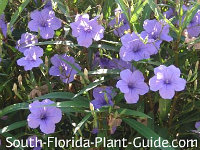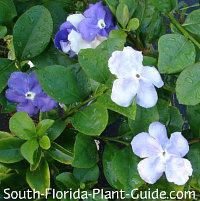Your Monthly Grow-zine
July 2014
Things to do in the garden this month...

Take in the beauty of summer color! South Florida landscapes are at their height of color and tropical foliage.
If you're looking to jazz up your landscaping, this is the time to take a drive around town to find plants to fall in love with. (Bring the camera!)
And be sure to visit your local plant nursery to see what's new...like the unique cordyline 'Roly" (pictured) which stays smaller and more compact than other cordylines.
Plant! Warm nights and lots of rain helps get things established quickly.
Be prepared to water twice a week - but only if there's been no rain. Rainy season usually takes care of this chore, but if there's a dry spell you may need to run your irrigation.
Pull weeds. Rainy season is weed season, too.
Check for insect damage. Bugs can invade quickly...the best defense is to examine your plants closely during a regular walk around the garden. Do this a few mornings a week (before the worst heat of the day sets in). If you notice a problem, seal cuttings in a plastic bag and show them to your local nursery for diagnosis.
July is a great time to...

Plant a moon garden!
White flowers and variegated foliage are visible at dusk - and create a unique setting for evenings by the pool or patio.
Or you can plant this grouping in a spot readily visible from indoors.
Here are some ideas of plants to use for a twilight showplace.
|
|
New!
EXCLUSIVE GROW-ZINE SERIES - COLOR FAMILIES
Cool Colors in the Landscape
Want to landscape your property but not sure how to use color? Choosing plants from a single color family can make it easy to get started and create a unifying look to the landscaping.
Color families are groups divided into 3 categories....warm, cool and neutral.
This month we'll discuss cool colors - blue, violet, and green.
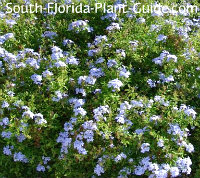 |
|
Cool colors have a calming effect. They evoke feelings of serenity and peace. They work well together in a garden color scheme that creates the illusion of more space.
If you have a small front yard, for example, blue, purple and green can actually make it appear larger and more expansive.
If you want to make one area stand out, add color wheel opposites - yellow or orange.
You can also add interest with variations of violet in shades of lavender, or even deep reds.
Visit your local nursery this month
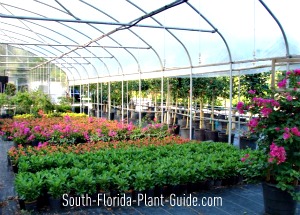
Unlike other parts of the country, this is a slow time of year for small, locally-owned nurseries and garden centers in South Florida.
Give them your support during slow season by stopping in for even a small purchase - potting soil, insecticide, garden gloves, plant stakes, etc.
Your patronage means a lot to these small businesses - and without it, they may not be around for you in the future.
Don't
buy garden stuff and plants from the box stores - your local nursery
may be an extra few miles away, but their livelihood depends on you. And
their knowledge and expertise are something you'll never find at a box
store.
What's new at South-Florida-Plant-Guide.com
I'm in the process of adding a handy Print This Page button to the Plant Pages of the website. This way you can print out info directly from each page (rather than using your browser's print function) to keep for reference on specific plants.
So far I've added the button to the palms and trees, and should have the rest of the Plant Pages done soon.
There's also a print button at the bottom of this page and all future grow-zines.
Need a "crash course" in South Florida plants - and how to use them in your yard?

My Column Collections ebooks - 5 books in all - are here and you can buy just one or own the whole set!
These are based on the best of my newspaper garden columns, packed with info about our wonderful and exotic plants and how to use them...including many things not covered at South-Florida-Plant-Guide.com.
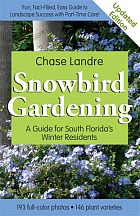
Are you a Snowbird?
Want to know more about growing a beautiful landscape with only part-time care?
Check out the new, updated edition of my book,
Snowbird Gardening.
I've added more plants, more photos and up-to-date info for South Florida Snowbirds.
This new edition features 146 plant varieties - palms, shrubs, trees and flowers - with photos and information about each one.
Thanks for subscribing to the Grow-zine!
If you have any
questions, comments or suggestions about what you'd like to see included
in the Grow-zine - or the website - please let me know!
Have a wonderful 4th of July!
Chase Landre

Take a crash course!
Ebooks on South Florida gardening!
Fertilizer blackout
Many - perhaps all - counties in Florida have adopted regulations to ban homeowners from fertilizing their lawns and gardens from June 1st through September 30th.
Check with your County Extension Service to find out what your local ordinances are.
Take a break!
The ultimate guide to low-maintenance plants
and landscaping!
An ebook by
Chase Landre
author of
South-Florida-Plant-Guide.com
Learn more!
Get a greener thumb!
Want to learn more about South Florida planting, watering, fertilizing and dealing with weeds and pests?
See our Gardening How-To section for answers!
Get instant curb appeal!
An ebook by
Chase Landre
author of
South-Florida-Plant-Guide.com
Learn how to get instant curb appeal with fast growing plants and landscaping techniques!
Tropical Hydrangea

The farther south in Florida you go, hydrangeas become pretty much impossible to grow.
Tropical hydrangea - also called Dombeya - doesn't have quite the show of real hydrangeas, but they're gorgeous plants just the same.
The larger variety (pictured above) is dombeya x cayeuxii.
It grows very quickly to a height of 10 feet or more, with drooping pink blossoms peeking out from large leaves.
The smaller variety (photo below) is dombeya x 'Seminole'.
It grows fast as well but you can keep it about 4 feet. Its flowers are a deeper pink and decorate the top of the plant - more hydrangea-like.
The seminole variety also does very well in a large container.
Both like a part sun to part shade situation. They need the warmth of Zone 10, and flower on and off all year.
Dombeyas can be a challenge to find, though the seminole may be special ordered at your local nursery. Otherwise, try looking for them at rare plant sales.

|
"What's eating my plant?" A visitor to the site asked what could be munching on his hibiscus shrubs. I asked my "bug expert" for his opinion. Here's his response: If the leaves are being eaten from the edges in... ...it's one of two things: caterpillars or grasshoppers. For caterpillars you can treat with thuricide (damage will still occur briefly as this is an ingested product). Grasshoppers, if young, can be treated with Bifenthrin based products. If they are adults your only defense is to catch and crush them. Young grasshoppers travel in large groups making them very easy to spot. Adults are singular travelers, but not great at camouflage, again easy to spot. If the damage starts in the middle of the leaf as well as the edges... ...it could be snails or slugs Treat with snail bait. My suggestion, do a little investigation after dark. You will learn a lot from that |
